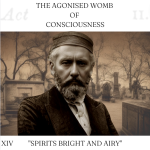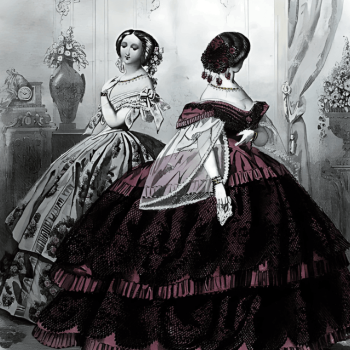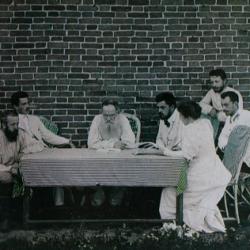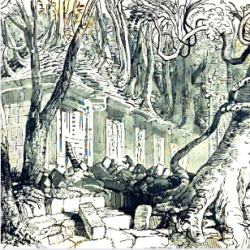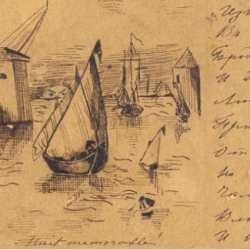THE SILENT PASSENGER
ACT II.
XII.
⸻
A dense mass of low-hanging fog enveloped the R.M.S. Umbria. It had done so ever since leaving the dock in New York, on the morning of November 11, 1888. It was 1 p.m. Most of the passengers were in the dining-salon for lunch. Though anxious to reach Ireland as soon as possible, most agreed that Captain McMickan was running the ship at a reckless speed—far too dangerous for such black weather. The crew of the Umbria secretly agreed, but no one dared question the captain.
Judge was en route to his natal country of Ireland, and too lost in thought to be distracted by the speed of the steamer. The death of his uncle Samuel, of course, lingered in his mind, and the loss of Sattay still burdened his heart. Foulke’s “flying visit” to New York, and the news which he carried, also jostled about in his mind.
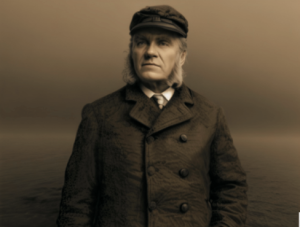
Captain McMickan.[1]
A faint whistle-signal came from the gloom. The more observant passengers heard it.
Then a second whistle. This one was louder and nearer. It was heard by everyone.
“We are going to hit her, captain!” shouted the first officer.
Directly across the bow, consumed in salty mist, a dark shape loomed closer.
“No,” Captain McMickan cried out, “I think we shall miss her!”
The sound of the collision was surprisingly subdued—like the tearing of paper.
All the passengers ran to the deck to survey the damage.
Behind the Umbria was a steamer, split in two, and thrashing aimlessly in the heavy sea. The derelict ship was quickly absorbed in mist once more. The Umbria cut her engines, but she was traveling far too fast to come to a complete stop. The passengers of the Umbria listened, helplessly, as eerie screams issued from the darkness.
“Mon Dieu!”
“Ya Allah Sa’edna!”
“Sóse mas!” “sóse mas!”
“Le premier homme à déserter le navire meurt!”
Long paragraphs of silence followed—run-on sentences of quiet dread punctuated only by the occasional fog-whistle of the desperate derelict.

The collision between the Umbria and Iberia.[2]
For thirty minutes the Umbria stalked the ever-darkening sea, until, at last, the quickly-sinking ship was found. The sun was long-gone by the time everyone was rescued. First-officer Guillot, being the most fluent in English, was the first to board the Umbria. The ship was the Iberia with a crew of thirty men—French officers, with a crew of Greeks, Portuguese, and Arabs. She was carrying a cargo of dates, hides, tobacco, and coffee, from Persia. Engine failure had forced her to anchor in the fog until the weather cleared. Captain McMickan delivered the men of the Iberia to New York, but he refused to tow the mangled Iberia. Enough time was already lost. Reluctantly, Captain McMickan returned to port for the Umbria to undergo the necessary repairs.[3]
Judge could not help but recall his experience on the Cephalonia and was grateful that no one had drowned.
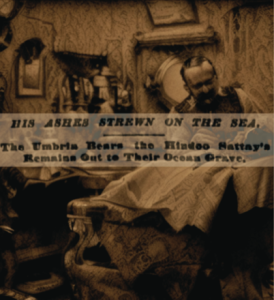
Ship Barber.
“Where is it?”
The passenger asked Judge what everyone on board wanted to know:
“Where is what?” Judge replied.
“Why,” said the passenger, “the barber says that you have a corpse on board!”
The inquisitor placed an edition of The New York Sun in front of Judge. The barber, it seemed, was giving a copy of that paper to everyone who came in for their morning shave.
“Of course it’s The Sun,” he thought, “it’s always The Sun.”
The article said:
His Ashes Strewn On The Umbria
The Umbria Bears The Hindoo Sattay’s Remains Out to Their Ocean Grave.
The New York and Brooklyn theosophists recently cremated the body of the Hindoo, S. Govinda Row Sattay, who died while on a visit to this country from Sholapore, India. Sattay, as he was familiarly called, was a finely educated man, and had arranged to remain in this city for the present, and teach Sanskrit. A number of theosophists had formed classes for the study of the metaphysical books to be found only in this dead language, and Sattay had just entered upon this work which, as a good Buddhist, he rejoiced to be engaged in here. His death was due to the rigors of this climate, which were particularly severe on his delicate frame…
The ashes were taken out on the Cunard steamer Umbria yesterday by the President of the Aryan Theosophical Society, William Q. Judge, who will scatter them over the waters of the Atlantic Ocean on the voyage to Liverpool. The Society of Theosophists inclined to forward them to his family in India, but the well-known principles of the Buddhists, which forbid honors to dead bodies, led them to adopt the course pursued.[4]
If people cared to look at the date, they would have realized that the issue was published the same morning as the Umbria’s initial departure. The Sun was in the business of printing news before it even happened it would seem.
Judge became a marked man. Whenever he took a walk on deck, watchful eyes followed his every movement.
The sailors whispered superstitions among themselves.
“There is to be a ritual at night,” they said, “when everything is quiet but the whistling winds in the rigging, and the mournful awash of the waves. That man Judge—the silent passenger—is going to chant some mystical words in that dead man’s language over the taffrail.”
Even bluff Captain McMickan drew a frown over his bronzed countenance when he learned about the rumor of Judge’s supposed ritual and ordered the understewards and waiters to keep a careful watch over him.
“He’s uncanny,” the passengers whispered.
“They say that he is storing the ashes in an upper berth.”
“I hear he’s sprinkling the ashes a pinch at a time.”[5]
At night when he would ascend, a crowd of passengers would follow.
It was said that the collision with the Iberia was due to the “Brahmanical corpse on board.”
One sailor even swore that he witnessed a “bronze-faced figure, clad in white, leading on in front of the vessel.”[6]
Judge thought once more on what Foulke had told him. Apparently, Eddy had conducted another séance in Foulke’s private room on the evening of November 8, 1888. Sattay appeared to them, “dressed exactly as he was won’t to dress, even to his neckcloth that he wore to protect his throat.” Sattay’s apparition, if Foulke was to be believed, told him that “there will be a sudden and wonderful spread of the teachings of Buddha in the near future.”[7]
← →
THE AGONIZED WOMB OF CONSCIOUSNESS SECTIONS: “ACT II”
I. THE LITTLE TOY TEMPLE ON NASSAU STREET.
II. UNION OF HEARTS.
III. IN DARKEST LONDON.
IV. NONSENSE OF BROKEN TEACUPS.
V. A CURIOUS REUNION ON WALNUT STREET.
VI. GLORIFIED IN THE LAND OF BABYLON.
VII. ALWAYS THIN AND GRAVE.
VIII. ET IN ARCADIA EGO.
IX. THEORY OF UTILITY.
X. APOLLO BUNDER.
XII. THE SILENT PASSENGER.
XIII. DECCAN PLATEAU.
SOURCES:
[1] [AI enhanced image] Photo of McMickan from: Dougherty, Charles Algernon. “The Transatlantic Captains.” Harper’s New Monthly Magazine. Vol. LXXIII No. CCCCXXXV. (August,1886): 375-391.
[2] [AI enhanced image] “The Collision Between The ‘Umbria’ And ‘Iberia.’”’ Harper’s Weekly. Vol. XXXII, No.1666. (November 24, 1888): 889.
[3] “Cut In Two At Sea.” The New York Tribune. (New York, New York) November 12, 1888; “Cut By A Cunarder.” The Daily Globe. (Saint Paul, Minnesota.) November 12, 1888; “Steamers In Collision.” The New Haven Daily Mail Morning Journal And Courier. (New Haven, Connecticut) November 12, 1888.
[4] “His Ashes Strewn On The Sea.” The Sun. (New York, New York) November 11, 1888.
[5] “Lawyer Judge Is Tired.” The Brooklyn Daily Eagle. (Brooklyn, New York) December 31, 1888.
[6] “Ashes Not Scattered.” The New York Times. (New York, New York) December 31, 1888.
[7] “Shade of Sattay.” The Independent Record. (Helena, Montana) November 22, 1888.



